Steemit Crypto Academy Contest / S5W2 - Get to know the Steem Blockchain
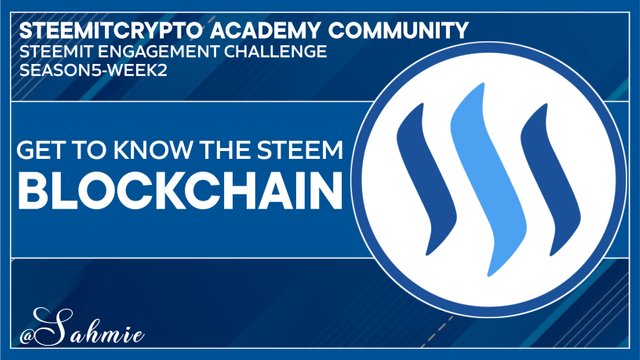
Designed using Pixellab App.
Hello everyone
Greetings to you all in this community as the Steemit Engagement Challenge Season 5 week 2 brought me here and this is my entry for the theme of this week's contest from this community.
Without further ado, let's get to the business of the day.
Talk about the consensus protocol used in Steem, the Delegated Proof of Stake. What are the differences between DPoS and PoW?
Proof of stake is a kind of consensus mechanism used to validate cryptocurrency transactions. This Proof-of-Stake mechanism allows owners of a cryptocurrency to stake their coins and create validator nodes for themselves.
Staking is when owners of cryptocurrencies pledge their coins to be used as a means of verifying transactions. The coins are locked up after the owner stakes them, but they can still unstake them if they eventually decide to trade them.
Under this mechanism, When a block of transactions is available for processing, the PoS protocol will choose a validator node to examine the block. The validator's work is to check if the transactions in the block are valid. If they are, then they add the block to the blockchain and receive crypto as a reward for their contribution. Nonetheless, if a validator submits a block with incorrect information, they lose some of their staked coins as a penalty. Examples of major cryptocurrencies that use proof of stake are Ethereum, Cardona, Tezos, Solana, Polkadot etc. Peercoin was the first cryptocurrency to introduce this mechanism in the year 2012.
Delegated Proof of Stake (DPoS) is identical to the Proof of Stake protocol, with a slight difference in how they work. DPoS stars a voting and delegation protocol that also comprises incentives for users. The incentive mechanism aids in securing the network with the coins staked by users.
Users have to stake their cryptocurrencies or tokens to participate in the Proof of Stake and delegated PoS consensus protocol. The working of delegated PoS is distinct from PoS in the fact that nodes or users elect witnesses or delegates for the block creation processes. In delegated PoS, only voters and appointed delegates can partake in validating transactions. Examples of cryptocurrencies that feature DPoS include Steem.
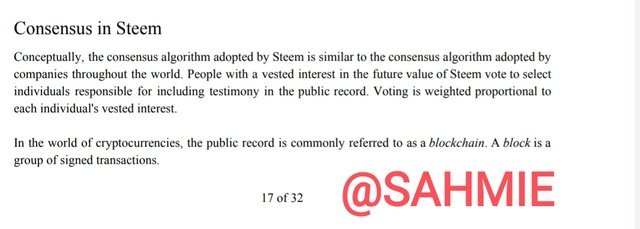
A screenshot from Steem White Paper
This is visible to see in the Steem white paper, page 17 under the Consensus in Steem header.
On the other hand, Proof of Work needs miners to unravel and decipher complicated math puzzles known as "cryptographic puzzles" to determine which network participants get the privilege to validate transactions and improve the blockchain.
PoW requires miners putting in “Work” to be rewarded with the means to verify and validate transactions on the blockchain. Thus, it is known as cryptocurrency mining, and it’s similar to a competition where everyone puts in their work to earn the right of verifying and validating a transaction. Bitcoin is popular for introducing the PoW mechanism.
How often does a block occur in Steem and how many tokens does it use? Discuss this topic.
According to the information on the Steem white paper, under the Consensus in Steem header, page 18, paragraph 5, a block is produced every 3 seconds. This is also backed by the Steem Blue paper, page 3, paragraph 2, under the header Delegated Proof of Stake (DPoS).

A screenshot from Steem White Paper
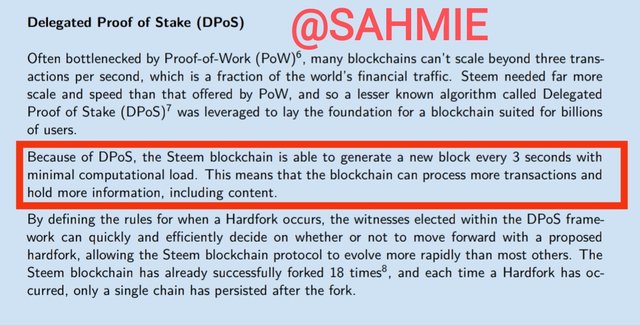
A screenshot from Steem Blue Paper
Since Steem employs a witness protocol, the logarithm appoints a witness randomly among the 20 selected witnesses, with 1 witness always on standby to replace any witness that could not perform.
The 21 active witnesses are shuffled every round to prevent any one witness from constantly ignoring blocks produced by the same witness placed before. - Steem White Paper
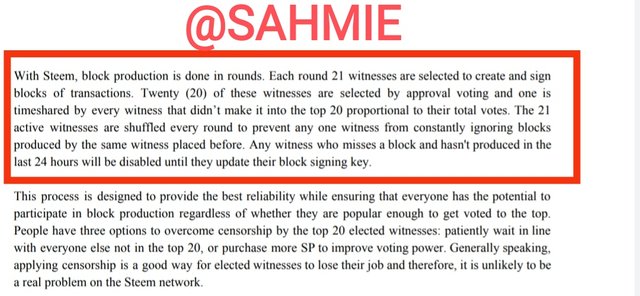
A screenshot from Steem White Paper
These witnesses, in turn, are appointed by voting from other users, this gives an edge to the operating procedures as it encourages a decentralized process.
With information from the Steem white paper, initially, the steem rewards were allocated in a PoW manner at a rate of roughly 40 STEEM per minute to the miners, with an extra 40 STEEM per minute being created to corn the content and curation prize pools (making it a total of 80 STEEM per minute).

A screenshot from Steem White Paper
After the network's 16th hard fork in December 2016, Steem commenced the creation of new tokens at a yearly inflation rate of 9.5%.
This inflation rate is said to decrease at a rate of 0.01% for every 250,000 blocks, or about 0.5% per year. Which continued until the overall inflation rate reaches 0.95%. This is estimated to take about 20.5 years from the time hard fork 16 went into effect which by estimate is June 2036.

A screenshot from Steem White Paper
75% of the new tokens that were generated said to fund the reward pool, which is split between authors and curators. With 15% of the new tokens believed to be awarded to holders of SP the remaining 10% goes to witnesses to power the blockchain.
All this above information are found on the Steem white paper from page 25 - 26.
Do you know what was the first application to run on the Steem Blockchain? Discuss this application.
From the information gathered in the cause of this research, Steem blockchain has over over 100s of authorized applications.
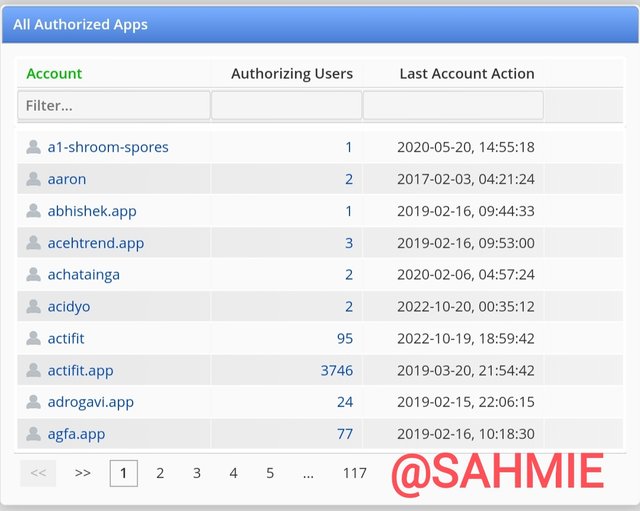
A screenshot showing 100s of authorized apps on steem blockchain from SteemWorld
But, according to CoinMarketCap, Steemit was launched on July 4th, 2016 as the first-ever application on the Steem block.
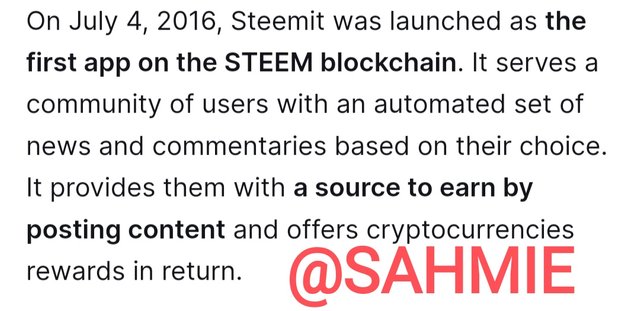
A screenshot from CoinMarketCap
Steemit is a social media platform that runs on the unique Steem blockchain. A blockchain-based social media model. It rewards content creators/bloggers with Steem tokens for their contributions.
On Steemit, users are tasked with the work of creating content that offers value to the network which in turn attracts new users to the platform while also maintaining the current user's interest and amusement. This in turn facilitates the dispersion of the Steem cryptocurrency to a larger number of users while also improving the network impact.
Users who take the time to curate or vote on the content published on Steemit help in the distribution of the coins to the users who created this valuable content. Depending on the collective Steem power in the stake-weighted voting means. Therefore, Steemit rewards both content creators and curators in proportion to their worth.
What is Proof of Brain (PoB)?

A screenshot from Steem Blue Paper
Proof-of-Brain, as described in the Steem blue paper is a token system that rewards users as they contribute to a token-based community system, it is also said to be a required mechanism for ascertaining and assessing content’s social value. This suggests PoB of having the following two features:
a pool of tokens assigned to incentivise content creation and curation (known as "rewards pool")
a voting system that leverages the knowledge of the users to ascertain the value of content and distribute tokens to it.
These two features work concurrently to enable the Steem blockchain to allocate a large portion of the block rewards to both curators and creators using human participation as the mining mechanism instead of utilizing electricity and finding hashes that the proof-of-work mechanism utilizes. In this mechanism, human work is valued here rather than the hash rate of some supercomputer army.
THANK YOU!
I like to invite @fredquantum, @Ruthjoe and @patjewell, and any other persons who would like to participate too to CLICK HERE for more instructions.

NOTE: Always have a smile on your face, as you are never fully dressed without one.


Thank you dear friend for the invite..
You have shown an indepth knowledge of the steem Blockchain. I love your knowledge from proof of brain, it different from what I have always known.
I am very excited to know I contributed to steem blockchain knowledge. Thank you for your time.
Thanks a lot have really learnt so much from this content
Nice post!
I've been waiting for a very long time to read about the Steem blockchain after I got to know about blockchains in general.
Now the puzzles are starting to fit.
Good luck for the contest!
I am very pleased to get such a heart felt feedback from you.. I really really appreciate your support. Thank you
The pleasure is all mine! 🤛
This is quite detailed I must say, you swept me off my feet with the effort you put into this entry. Weldone dear friend. Your future on this platform is indeed bright. Keep up with the quality.
I think am having butterflies in my stomach right now.. Thank you for your heart felt remarks it means a lot to me.
Excellent explanation regarding steem blockchain.
You explain each topic with proofs,thats great.
Nice entry from you. Best of luck my friend.
Thank you for your time and warm regards to you.
Your explanations on this part is very detailed and understanding bro. Nice work done
Thank you for your kind support. I am glad you understood it perfectly. Thank you once again
Welcome
Ahh the important of meaningful engagement can't be overemphasize, thanks for the detailed explanation of our beloved platform Blockchain. I wish you success!
A very detailed and interesting article you have here friend, as I have got to now know that they're 20 Active witnesses and 1 witness is at standby.
I equally get to know that 75% of the newly generated token are used to reward the pool. Thanks for sharing and goodluck in this contest.
Thank you for your warm feedback, it motivates me to even do more.